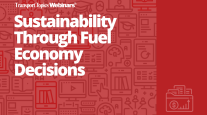US Proposal Promises to Lower Emissions, But Costs, Confusion Could Hinder Efforts
If the new federal proposal on truck greenhouse-gas emissions works as intended, heavy-duty vehicle manufacturers will round up existing technologies — and perfect some new ones — to produce big rigs that are more expensive but also much more efficient.
Fleets would save money on their fuel bills. Shippers and the nation’s consumers also would capture benefits from greater efficiency. Perhaps even freaky weather from climate change would be tempered by a dollop.
Then again, the nation might just see a lot of extra costs and confusion.
At some point in the 2030s, experience will measure where the country landed between these extremes, but there are some useful points to consider as trucking begins to march down the path of Phase 2 of the greenhouse-gas rule.
The Environmental Protection Agency started caring about greenhouse gases from trucks fairly recently. From 1998 through 2010, EPA’s focus was on nitrogen oxide (NOx) compounds and particulate matter.
NOx and soot are real hazards, but the problem with fighting them in the rules of 2002, 2007 and (to a lesser extent) 2010 is that diesel engines got more expensive and less reliable at the same time. Benefits were spread broadly across the public, but costs were concentrated on truck owners.
The 2010 rule was a special case in that selective catalytic reduction reduced NOx output and improved mileage over the much-disliked 2007-2009 engines.
Then came Greenhouse Gas Phase 1 by EPA and the National Highway Traffic Safety Administration in January 2014. This was the mechanical equivalent of “Who wants pizza?” The grim, dutiful, enduring of the NOx era was replaced by the joyful quest for better mileage — a trucker’s favorite treat.
The one sure way to reduce carbon dioxide emissions is to burn less fuel, and the best way to do that — short of a return to freight in ox carts — is to make more efficient engines. Fleets clamor to buy them, even if it’s only a 0.1 mpg improvement, and truck makers boast endlessly of their pursuit of making them.
The EPA-NHTSA proposed rule just issued will test how eager fleets are to pay for pizza.
The regulatory documents say engines must get 4.2% more efficient from 2017 to 2027 as part of an overall gain of 24%. The agencies say this will make a tractor more expensive, by about $12,000, but fuel savings will generate a 24-month return on investment with profit the residue after that.
That actually sounds similar to American Trucking Associations, which usually likes to see an 18-month payback for mandated vehicle improvements. ATA President Bill Graves didn’t endorse the proposal unequivocally but said the federation supports the aim of the rule.
EPA and the U.S. Department of Transportation appear to be listening to industry input.
After Phase 1 rolled into effect, original equipment manufacturers gave credit to Obama administration regulators for making an honest effort to understand the industry.
But there are doubters with reasonable concerns. The American Truck Dealers is worried that the piling on of new technologies could lead truck buyers to pass when new models are rolled out over the next decade. The sales plunge in 2007-2009 stemming from 2007 regulatory change was so severe that truck dealers cannot stand the thought of any sort of repeat.
The Owner-Operator Independent Drivers Association is worried about cost and reliability. The only thing worse than a big jump in truck prices is when the affected vehicles are filled with cool ideas that don’t work. Class 8 trucks are sold on the idea of million-mile lives, so mandatory technology that doesn’t work is crushing.
Some people also worry that projected benefits are over-stated and costs are minimized.
Many recent technological improvements have been layer on top of layer of 0.25% to 1% increases, bound together until the cumulative change becomes substantial. Diesel is a very mature technology with a lot of engineers, so it’s hard to suddenly stumble upon a major improvement.
The possible exception is waste-heat recovery, kind of like putting a steamboat under a truck hood. Waste-heat recovery harnesses heat surging from combustion in cylinder heads and uses it to turn a liquid into a gas and then power a turbine.
It’s a beautiful idea because there’s an abundance of heat energy surrounding the engine, and that energy always has been wasted. Correcting that loss would be groundbreaking.
The huge challenge is getting waste-heat recovery to work economically and reliably in an already-very-crowded area under the hood. Peterbilt Motors Co. and Cummins Inc. used a waste-heat system in their SuperTruck entry to the U.S. Department of Energy.
A Peterbilt engineer said the system is compelling but could offer no guidance on when it might be available for purchase.
This is such stuff that dreams are made of.




